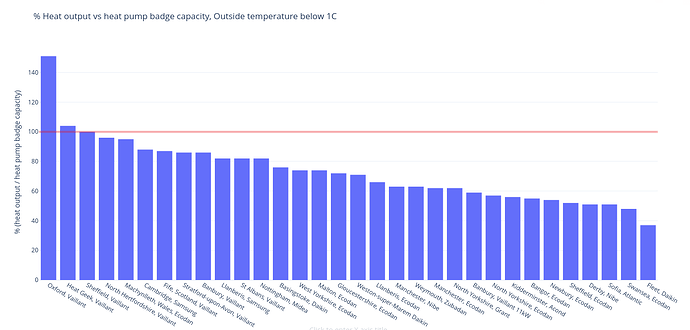Hello Andrew, Ken, great to see you both on here! and thanks for posting this up here Andrew.
One question I have in my mind at the moment is what is the actual capacity of each heat pump during regular defrost conditions? I think it might be lower than some? manufacturers are stating on the datasheets, mostly going on the Daikin I mentioned, I may be wrong about this, It would be interesting to try and excercise next winter during near zero conditions to try and max out our heat pumps over a 4 hour period to see how close to datasheet output they can achieve? This is clearly not an issue for the Vaillants on there which have datasheet capacities above their badge.
Building on the earlier table above, I thought I would try finding the maximum output of each heat pump on the list over a 4 hour period where outside temperatures were below 1C. The script that I’ve put together to generate the following can easily be modified to change the period to e.g 2 hours, or filter for specific outside temperatures, so happy to re-run this with different parameters, here are the results:
| location | heatpump output | heatpump model | heat loss survey | heat demand | div 2.9 | Max output below 1C | Outside temp | % of heatpump output | % of heat loss |
|---|---|---|---|---|---|---|---|---|---|
| Oxford | 3.5 | Vaillant Arotherm+ | 3 | 7500 | 2.6 | 5.3 | -7.5 | 151% | 177% |
| Heat Geek Towers, Camberley | 5 | Vaillant Arotherm+ | 5 | 6000 | 2.1 | 5.2 | -2 | 104% | 104% |
| Sheffield | 5 | Vaillant Arotherm+ | 5.4 | 9000 | 3.1 | 5.0 | 0.5 | 100% | 93% |
| North Hertfordshire | 5 | Vaillant Arotherm+ | 6 | 8000 | 2.8 | 4.8 | -9 | 96% | 80% |
| Machynlleth, Wales | 6 | Mitsubishi Ecodan | 1.5 | 7500 | 2.6 | 5.7 | 0.5 | 95% | 380% |
| Cambridge | 8 | Samsung HTQ | 7.8 | 10897 | 3.8 | 7.0 | -2.5 | 88% | 90% |
| Fife, Scotland | 7 | Vaillant Arotherm+ | 0 | 23500 | 8.1 | 6.1 | -7.5 | 87% | |
| Stratford-upon-Avon | 7 | Vaillant Arotherm+ | 7.57 | 7300 | 2.5 | 6.0 | -2 | 86% | 79% |
| Banbury | 7 | Vaillant Arotherm+ | 6.5 | 0 | 0 | 6.0 | -2 | 86% | 92% |
| Llanberis, Gwynedd | 5 | Samsung Gen 6 | 3.5 | 8000 | 2.8 | 4.1 | -1 | 82% | 117% |
| St Albans | 5 | Vaillant Arotherm+ | 4.1 | 9143 | 3.2 | 4.1 | 0.5 | 82% | 100% |
| Nottingham | 12 | Midea | 8 | 11332 | 3.9 | 9.8 | -0.5 | 82% | 123% |
| Basingstoke | 10.6 | Daikin 11kw monobloc | 9.8 | 21000 | 7.2 | 8.1 | 0.5 | 76% | 82% |
| West Yorkshire Peak District | 8.5 | Mitsubishi Ecodan | 8 | 15452 | 5.3 | 6.3 | -1.5 | 74% | 79% |
| Malton, North Yorkshire | 14 | Mitsubishi Ecodan | 14 | 41699 | 14.4 | 10.3 | -4 | 74% | 74% |
| Gloucestershire | 5 | Mitsubishi Ecodan | 3.5 | 7200 | 2.5 | 3.6 | 0.5 | 72% | 103% |
| Weston-super-Mare | 7 | Daikin EDLQ07CV3 | 0 | 9524 | 3.3 | 5.0 | -1 | 71% | |
| Llanberis, Gwynedd | 5 | Mitsubishi Ecodan | 4.5 | 8000 | 2.8 | 3.3 | -3.5 | 66% | 73% |
| Manchester | 6 | NIBE F2040-6 | 3.5 | 7000 | 2.4 | 3.8 | -4 | 63% | 109% |
| Weymouth | 14 | Mitsubishi Zubadan | 0 | 27328 | 9.4 | 8.8 | 0 | 63% | |
| Manchester | 5 | Mitsubishi Ecodan | 3.4 | 9500 | 3.3 | 3.1 | -0.5 | 62% | 91% |
| North Yorkshire | 6 | Grant Aerona3 | 6.25 | 15500 | 5.3 | 3.7 | -5 | 62% | 59% |
| Banbury | 8.2 | Vaillant Arotherm+ | 7.6 | 0 | 0 | 4.8 | 0.5 | 59% | 63% |
| North Yorkshire | 11 | Mitsubishi Ecodan | 9.4 | 22000 | 7.6 | 6.3 | -2 | 57% | 67% |
| Kidderminster | 7 | Acond PRO-N | 37 | 6570 | 2.3 | 3.9 | -1.5 | 56% | 11% |
| Bangor, Wales | 11 | Mitsubishi Ecodan | 5.5 | 11000 | 3.8 | 6.0 | 0.5 | 55% | 109% |
| Newbury | 14 | Mitsubishi Ecodan | 11.5 | 12000 | 4.1 | 7.5 | -2.5 | 54% | 65% |
| Sheffield | 11.2 | Mitsubishi Ecodan | 9.989 | 23594 | 8.1 | 5.8 | -1 | 52% | 58% |
| Derby | 8 | NIBE F1145 | 0 | 4542 | 1.6 | 4.1 | -1.5 | 51% | |
| Sofia, Bulgaria | 8 | Atlantic Alfea Extensa | 5 | 12800 | 4.4 | 4.1 | -8 | 51% | 82% |
| Swansea | 11.2 | Mitsubishi Ecodan | 0 | 30000 | 10.3 | 5.4 | 0.5 | 48% | |
| Fleet, Hampshire | 12.12 | Daikin Altherma | 0 | 12700 | 4.4 | 4.5 | 0 | 37% |
Plot of max heat output over 4 hour period as a proportion of badge capacity (outside temp below 1C)
I should overlay this with the max heat output over a 24 hour period to see how it changes…
